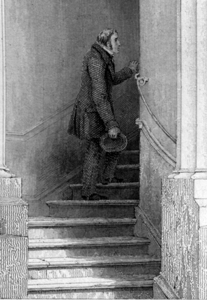Pictures in Print - The scope of the project
The material to be included in the project was defined quite tightly, as must be the case with any short term task, with the intention that more items would be added where possible. It was set at loose maps and prints and those in extra-illustrated volumes, as this was the only area that could be easily quantified. While it would prove necessary to look at prints in the books in which they were published, it was not possible in the time available to do a survey of all the books in our collections to locate relevant material. Even if they had not been sorted, our loose prints and maps were at least collected in one location,
so some estimate of the work involved could be made: to make such an assessment for books containing relevant prints was not feasible.
 The time period covered is attributable both to the material itself and existing work done in the County. The first printed maps for the County appear in Elizabethan times, with topographical prints appearing slightly later, which sets the start date for the project. By the late nineteenth century, printing technology is changing rapidly leading to new, more diverse book illustrations, and of course photography transforms the process of recording images of places. This transformation makes it much more difficult to maintain a distinction between published and unpublished items, as well as keeping track of "editions" of an image, in the way that was more reliable in the days when an image was stored by cutting it into a metal plate.
The time period covered is attributable both to the material itself and existing work done in the County. The first printed maps for the County appear in Elizabethan times, with topographical prints appearing slightly later, which sets the start date for the project. By the late nineteenth century, printing technology is changing rapidly leading to new, more diverse book illustrations, and of course photography transforms the process of recording images of places. This transformation makes it much more difficult to maintain a distinction between published and unpublished items, as well as keeping track of "editions" of an image, in the way that was more reliable in the days when an image was stored by cutting it into a metal plate.
The publication of the large scale maps of the County by the Ordnance Survey in the 1850s marks a distinct cut-off point for maps. From this time, accurate maps would in the main be based upon this data rather than being surveyed on the ground (or more or less plagiarised from predecessors' work).
The dates chosen also ensured that the prints were out of copyright and could be scanned and placed on the WWW. Finally, the period dovetailed neatly into a project already completed by Durham County Council's Arts, Libraries and Museums Department, The Durham Record, which digitised large scale Ordnance Survey maps and photographs relating to County Durham.
Back to table of contents
Page maintained by Richard Higgins (e mail - r.i.higgins@durham.ac.uk). Last revised: May 2004
 The time period covered is attributable both to the material itself and existing work done in the County. The first printed maps for the County appear in Elizabethan times, with topographical prints appearing slightly later, which sets the start date for the project. By the late nineteenth century, printing technology is changing rapidly leading to new, more diverse book illustrations, and of course photography transforms the process of recording images of places. This transformation makes it much more difficult to maintain a distinction between published and unpublished items, as well as keeping track of "editions" of an image, in the way that was more reliable in the days when an image was stored by cutting it into a metal plate.
The time period covered is attributable both to the material itself and existing work done in the County. The first printed maps for the County appear in Elizabethan times, with topographical prints appearing slightly later, which sets the start date for the project. By the late nineteenth century, printing technology is changing rapidly leading to new, more diverse book illustrations, and of course photography transforms the process of recording images of places. This transformation makes it much more difficult to maintain a distinction between published and unpublished items, as well as keeping track of "editions" of an image, in the way that was more reliable in the days when an image was stored by cutting it into a metal plate.